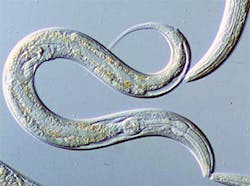Flatbed scanner tracks worm characteristics
Scientists from the University of Queensland's (Brisbane St Lucia, Queensland) School of Biological Sciences have developed a simple method they say can be used by scientists around the globe to more easily assess the phenotypes of the blind worms Caenorhabditis elegans (C. elegans).
There are four main phenotypes -- or observable characteristics or traits -- that are assessed in studies of C. elegans -- mortality, movement, potential reproductive capacity and size.
Neal Matthew, who is studying for his PhD under the supervision of Associate Professor Paul Ebert, said that the novel method known as WormScan requires no more than a flatbed scanner and improves counting rates and accuracy as it is nearly 100 percent efficient.
"WormScan uses light stimulus from the scanner instead of a physical stimulus from a worm pick to induce movement. With two sequential scans it is possible to quantify the response (using a bespoke software package)," says Matthew, who is completing a Master of Philosophy in Associate Professor Ebert's laboratory.
"WormScan can be used in a wide range of additional C. elegans studies including lifespan determination, development, pathology and behavior. We have even adapted the method to study other species of similar dimensions," he adds.
Associate Professor Ebert said that the software package they have developed is freely available for use or modification by other research groups.
More information is available here.
-- by Dave Wilson, Senior Editor, Vision Systems Design
